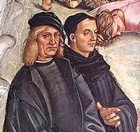
Luca Signorelli (left) and Fra Angelico (right)
Detail from the End of Days (1500-4) by Luca Signorelli,
Cappella Nuova, Duomo, Orvieto
Luca d' Egidio di Ventura, known as Luca Signorelli, came from Cortona. According to Giorgio Vasari (whose great grandfather had been Signorelli’s uncle), Signorelli trained under Piero della Francesca. Vasari also recollected that Signorelli “lodged in the house of the Vasari [in Arezzo] when I ... was a little boy of eight years old, [and] I remember that the good old man, who was most gracious and courteous”.
Signorelli might well have worked with Perugino in the frescoes (1481-2) of the Sistine Chapel. Giorgio Vasari claimed that claimed that Pope Sixtus IV called him to Rome to work on the project “in competition with many other painters” and that he painted two of the best scenes:
-
✴the death of Moses, by which he probably meant one of the now-lost frescoes on the entrance wall.
It is quite possible that Signorelli did work with Perugino towards the end of the project, or even that he took over the project when the other artists left:
-
✴his extensive participation has been detected in the Testament of Moses; and
-
✴he may have contributed figures in the scene of Christ giving the keys of Heaven to St Peter.
Signorelli’s first important undisputed commission as an independent artist was the Sant' Onofrio Altarpiece (1484) in the Duomo Perugia (see below), by which time he was about 35 years old. He was granted citizenship of Città di Castello in 1488, and was the leading artist in the city for most of the 1490s (see below).
Signorelli is best remembered for his cycle of frescoes (1500-4) depicting scenes from the Last Judgement in the Cappella Nuova of the Duomo of Orvieto (see below). Having seen this work, Giorgio Vasari commented: “I do not marvel that the works of Luca were ever very highly extolled by Michelangelo, nor that in certain parts of his divine Judgement, which he made in the [Sistine Chapel, Michelangelo] should have deigned to avail himself in some measure of the inventions of Luca, ... as all may see”.
Signorelli seems to have been badly affected by the death of his son, Antonio, during an epidemic of plague in 1502. It is also possible that the commission at Orvieto had exhausted his creative and emotional reserves. For whatever reason, he spent the last 20 years of his life as a provincial artist, mostly in his native Cortona.
Città di Castello
As noted above, Luca Signorelli was granted citizenship of Città di Castello in 1488. The relevant document reveald that he was, at that time, painting a processional banner for the “fraternitatis gloriose Virginis Marie”, a prominent Marian lay confraternity, but this work no longer survives.
He was the leading artist in the city for most of the 1490s. He had a close relationship with the ruling Vitelli family. His departure from the city in ca. 1498 seems to created an opportunity for the young Raphael.
Surviving Works in and near the City
All of his surviving works in the city (listed below) are now in the Pinacoteca Comunale:
Fresco fragments (1474)
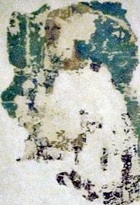
The fresco was apparently in good condition until the earthquake of 1789. It was attributed to Luca Signorelli in 1832 (if not before), and this is generally accepted. If the attribution is indeed correct, it is among Signorelli’s earliest works. It suffered further damage when it was detached in 1935. (Judging from this illustration in Wikimedia, it has suffered yet further deterioration since).
Martyrdom of St Sebastian (ca. 1498)
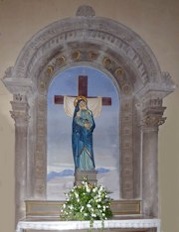
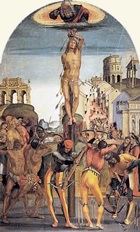
Giorgio Vasari referred to this work (“St Sebastian on [a] panel”) in San Domenico in his entry on Luca Signorelli in the “Lives of the Artists” (1550). It came from the Cappella di San Sebastiano, and its original frame survives there (illustrated above, on the left). It once contained the inscription:
THOMAS DE BROZZIS ET FRANCESCA UXOR
FIERI FECIT MCCCCLXXXXVIII
(Tommaso Brozzi and his wife, Francesca [Cesari]
had this work made: 1498)
The will of Tommaso Brozzi records that he had indeed established this chapel in 1498, and the surviving frame bears his arms.
The circumstantial evidence provided by the frame suggests that Tommaso Brozzi commissioned Signorelli’s altarpiece in ca. 1498. It was probably Signorelli’s last work in Città di Castello before he left for Orvieto. It remained in situ until at least 1856, and was transferred to the gallery in 1867.
The frame of the Signorelli altarpiece had an almost identical pendant on the opposite side of the church that later housed the altarpiece (1502-3) of the Crucifixion with Saints (the Mond Crucifixion) by Raphael. Raphael clearly had the opportunity to study Signorelli’s altarpiece as he worked on his own commission in the church. Indeed, a sketch (ca. 1500) by Raphael of one of Signorelli’s figures (the archer to the right who faces away from the viewer) survives in the Ashmolean Museum, Oxford.
Gonfalon (ca. 1500)
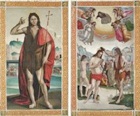
-
✴One face depicts St John the Baptist and three scenes from his life:
-
•St John in the desert;
-
•the trial before Herod; and
-
•the feast of Herod.
-
✴The other face depicts the Baptism of Christ.
The work is generally though to be from the workshop of Luca Signorelli. Following its restoration in 2011, Tom Henry (2012, referenced below) judged that the first side was indeed probably a workshop production, but that the second side was probably largely the work of Signorelli himself.
Santa Cecilia Altarpiece (1516-7)
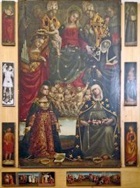
The frame no longer survives, and the surviving original components are displayed separately:
-
✴The composition of the central panel is in three tiers:
-
•In the upper part, the enthroned Madonna and Child are flanked by:
-
-SS Francis and Bonaventura, on the left; and
-
-SS Louis of Toulouse and Antony of Padua, on the right.
-
•SS Cecilia (whom Christ crowns) and Clare stand to the sides.
-
•SS Catherine of Alexandria and Elizabeth of Hungary kneel below.
-
All of the saints except SS Francis, Antony of Padua and Clare are richly dressed.
-
✴The surviving pilaster panels depict:
-
•St Bernardino of Siena;
-
•St Jerome;
-
•John the Baptist;
-
•St Lucy; and
-
•St Margaret of Antioch.
-
The sixth pilaster panel, which depicted St Michael, was stolen in 1986 and is replaced in the gallery by a monochrome copy.
-
✴The surviving panels that derived from the originally single predella depict the martyrdoms of:
-
•St Cecilia;
-
•St Valerian (her fiancé); and
-
•St Tibertius (St Valerian’s brother).
Frescoes at San Crescentino, Morra (1507-10)
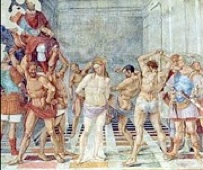
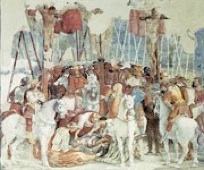
The frescoes in the Oratorio di San Crescentino, Morra are mostly attributed to Luca Signorelli and his workshop. They comprise:
-
✴those in the niche behind the high altar, which depict the Risen Christ with St Mary Magdalene and an unidentified hermit saint;
-
✴those in niches in the side walls, which depict:
-
•the Madonna di Loreto, on the left; and
-
•the Madonna della Misericordia with members of the confraternity, on the right; and
-
✴scenes from the Passion:
-
•on the left:
-
-Christ in the Garden of Gethsemane;
-
-the Last Supper; and
-
-the Flagellation (illustrated above); and
-
•on the right, the Crucifixion (illustrated above), of which only the lower part survives.
Signorelli’s Dispersed Works from Città di Castello
Madonna and Child with Saints (1493)
Payments were made in 1493 to Luca Signorelli for this altarpiece for the high altar of Santa Maria dei Servi (Santa Maria delle Grazie). It was in the sacristy in ca. 1726, when it was said to depict the Madonna and Child with SS Floridus, Peter, Paul and Amantius. Unfortunately, it no longer survives.
Adoration of the Magi (1493-4)
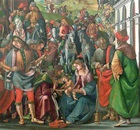
The Vitelli family probably influenced the choice of subject of the altarpiece: like the Medici and the Baglioni families, they probably identified the theme with princely patronage. The figure in a red hat and on horseback at the top right has been variously identified as Camillo, Paolo or Vitellozo Vitelli.
The altarpiece was documented on the high altar of Sant’ Agostino in 1627. This altar and its altarpiece were sold to Pope Pius VI after the earthquake of 1789. The Emperor Napoleon III acquired its main panel in the sale of the collection of the disgraced Roman collector, Giovanni Pietro Campana in 1861, and it is now in the Musée du Louvre, Paris. A panel of the Annunciation in the Philadelphia Museum of Art might have originally belonged to its predella.
Nativity (ca. 1493)
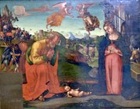
Portraits of the Members of the Vitelli Family (1490s)
Three surviving panels that have long been attributed to Luca Signorelli contain profile portrayals of members of the Vitelli family:
-
✴Nicolò Vitelli (inscribed N V), now in the Barber Institute of Fine Arts, Birmingham, UK: and
-
✴ two of his sons, Vitellozzo (inscribed V V) and Camillo, now in the Berenson Collection, Villa I Tatti, Florence.)
Tom Henry (2012, referenced below) has dated them on stylistic grounds to the 1490s, in which case the portrait of Nicolò Vitelli (died 1486) was posthumous.
There are 19th century copies of all three of these portraits in the Pinacoteca Comunale. A similar copy there, of a portrait of Paolo Vitello (another of Nicolò’s sons), could relate to a lost original by Signorelli.
Adoration of the Shepherds (1496)
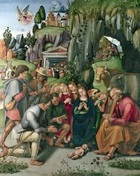
Perugia
Sant' Onofrio Altarpiece (1484)
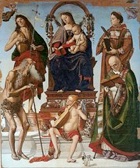
The altarpiece depicts the Madonna and Child with SS Humphrey ( dressed as an unkempt hermit), John the Baptist and Laurence and an unidentified bishop. This last figure is probably St Herculanus, who is perhaps portrayed using a portrait of Jacopo Vagnucci. (This figure does not have a halo. but a drawing in the British Museum on which it seems to have been based does).
During a recent restoration, traces of what seems to have been an imposing wooden frame were uncovered. The form of this frame is unknown, but it could have also included a predella. A small panel in the Louvre, Paris, which is attributed to Signorelli and depicts the birth and naming of St John the Baptist might have belonged to it. It is also possible that the inscription mentioned above was at its centre.
When this chapel was destroyed 1608, the altarpiece was moved a series of other locations in the Duomo: it was, for example, documented near the sacristy in 1674. It became the major exhibit in the newly instituted Museo Capitolare in 1923.
Altarpiece of the Franciscans (1517)
This damaged work is signed by Luca Signorelli and dated by inscription, but seems to have been largely a workshop production. It came from came from the Observant Franciscans' Convento di Sant’ Antonio di Padova, Paciano Vecchio, outside Perugia. The work survives in its original frame in the deposit of the Galleria Nazionale:
-
✴The main panel depicts the Madonna and Child in glory with SS Michael, Laurence, Francis, Sebastian, Antony Abbot and Antony of Padua. (The kneeling figures of SS Francis and Antony of Padua in the foreground could be by Signorelli himself).
-
✴The predella patterns relate to four of the depicted saints:
-
•the dream of Pope Innocent III, in which St Francis supports the Church (represented by San Giovanni Laterano, Rome);
-
•the martyrdom of St Laurence;
-
•the meeting of SS Antony Abbot and Paul the Hermit in the Egyptian desert; and
-
•the miracle of St Antony of Padua and the dead miser's heart (which was found to contain his money, as the saint had predicted).
Orvieto
Work in the Cappella Nuova, Duomo (1499-1504)
First Vault
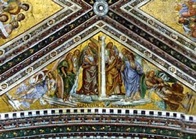
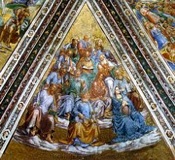
Angels with the instruments of the Passion Virgin and the Apostles
Fra. Angelico began the decoration of the Cappella Nuova in 447, but left Orvieto after only three months. The project stalled for a period and was then beset by a number of false starts. Finally, in April 1499, after a decade of legal wrangling with Perugino, the Opera del Duomo signed a contract with Luca Signorelli for the completion of the vault nearest the altar, following drawings left behind by Fra. Angelico. Signorelli completed the last two vanes of the vault in only six months. These depict:
-
✴angels with the instruments of the Passion; and
-
✴the Virgin and the Apostles.
(Perugino might have already painted two of the angels on the first of these scenes.)
Second Vault
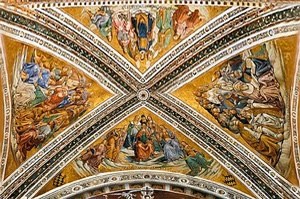
The Opera del Duomo then unanimously agreed to commission Signorelli to paint the second vault of the chapel with scenes depicting “choruses” of specific categories of saints:
-
✴virgins;
-
✴patriarchs;
-
✴martyrs; and
-
✴confessors.
The first of these scenes contains two sets of Monaldeschi arms, which probably reflect the small bequests made in the wills of:
-
✴Achille di Baccio Monaldeschi, in 1494; and
-
✴Pietro Antonio Monaldeschi, in 1495.
Last Judgement (1500-4)
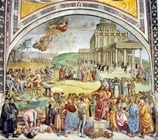
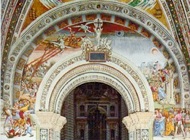
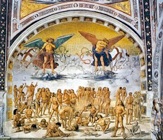
Preaching of the Antichrist End of the world Resurrection of the dead
Entrance wall
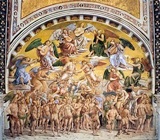
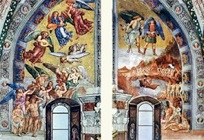
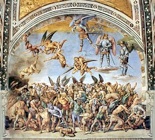
Assembly of the elect Ascent of the elect: expulsion of the damned Punishment of the damned
Altar wall
In early 1500, as work on the vaults of the chapel was nearing completion, Signorelli submitted his plans for its walls to the Opera del Duomo. These were duly accepted, albeit not unanimously, and Signorelli was commissioned to carry out the work. Giovanna Monaldeschi made a modest donation to the project from the estate of her husband, Pietro Antonio Monaldeschi.
Although the subject of the wall frescoes was clearly predetermined when Fra’ Angelico frescoed Christ in judgment above the altar, it was made more poignant by the plague that ravaged Orvieto at the start of the new century. Luca Signorelli dramatically captured the millennial fervour that gripped the city, and the result was his masterpiece. Giorgio Vasari (who was related to Luca Signorelli and had childhood memories of him as an old man) recorded that Signorelli: “painted all the scenes of the end of the world with bizarre and fantastic invention: angels, demons, ruins, earthquakes, fires, miracles of the Antichrist, and many other similar things besides, such as nudes, foreshortenings, and many beautiful figures; capturing the terror that there shall be on that last and awful day. ... I do not marvel that the works of Luca were ever very highly extolled by Michelangelo, nor that in certain parts of his Divine Judgement, which he made in the [Sistine Chapel, Michelangelo] should have deigned to avail himself in some measure of the inventions of Luca, ... as all may see”.
The cycle depicts the events that were expected at the approach of the Day of Judgement:
-
✴The scenes in the entrance bay depict the events of the Last Days:
-
•To the right of the entrance, the Antichrist preaches outside the Temple in Jerusalem, a building modelled on the then-current plans for St Peter’s, Rome. (Signorelli painted himself and Fra’ Angelico among the listeners, at the far left.)
-
•Above the entrance are the signs that signal the end of the world, taken from the Book of Revelations. (The arms of the Opera del Duomo are at the centre.)
-
•To the left of the entrance, the dead arise to face judgment.
-
✴The scenes in the altar bay depict the Last Judgement itself:
-
•On the altar wall, immediately below Fra’ Angelico’s Christ in Judgement, the elect are assembled to His right while the damned are herded to His left.
-
•In the next lunette on the left wall, the elect reach paradise.
-
•In the next lunette on the right wall, the damned pass through purgatory into hell.
Decoration of the Socle
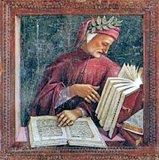
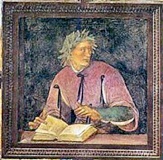
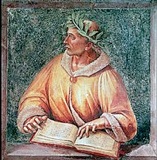
Dante Ovid Virgil
The lower part of the walls contains imaginary portraits of literary figures, including:
-
✴Virgil, surrounded by four grisaille scenes from the Georgics and the Aenid;
-
✴Ovid, surrounded by four grisaille scenes from the Metamorphoses; and
-
✴Dante, surrounded by four grisaille scenes from the Purgatorio (part of the Divine Comedy).
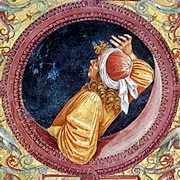
Pietà with SS Faustinus and Peter Parenzo (1504)
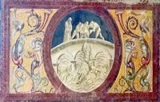
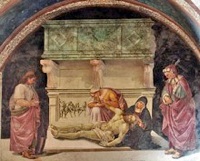
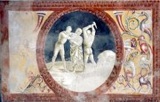
Martyrdom of St Faustinus Martyrdom of St Peter Parenzo
The contract between the Opera del Duomo and Luca Signorelli of 1500 included the redecoration of the Cappellina dei Corpi Santi, which hosed the relics of St Faustinus and St Peter Parenzo. Payment for the building of a wall in front of the existing fresco is recorded in 1502-3. The new fresco, which was executed on this wall, depicts the Virgin's lamentation over the Dead Christ with SS Mary Magdalen, Faustinus and Peter Parenzo. The scene is set in front of a sarcophagus that contains a fictive relief of the Deposition of Christ. Scenes of the martyrdoms of St Faustinus and St Peter Parenzo are depicted in tondi in the shallow sidewalls of the chapel.
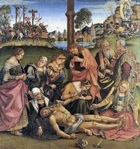
St Mary Magdalene (1504)
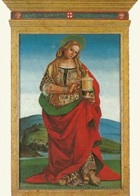
This altarpiece, which is by Luca Signorelli, depicts St Mary Magdalene standing in a landscape. It is painted on wood and might have been originally conceived as a processional banner. The inscription along the bottom of the panel records that the Conservatori della Pace (the elected officials who were charged with maintaining peace between the city’s factions) commissioned the work, which was dedicated to “she who keeps the peace”, and gives the date 1504. The lintel of the frame bears the names of two of the commissioning magistrates, “CECCARELLUS DE ADVIDVTIS ET RVFINVS ANTONII, together with their arms and those of the Commune.
Luca Signorelli and Nicolò d' Agnolo Franchi (1504?)
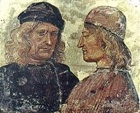
Read more:
T. Henry, “Life and Art of Luca Signorelli” (2012), London
F. De Chirico et al. (Tds), “Luca Signorelli” (2012), Milan,
which is the catalogue of the exhibition that was held in Perugia, Orvieto and Città di Castello
L. Kanter and T. Henry, “Luca Signorelli: The Complete Paintings” (2002), New York
The attempted requisition of the altarpiece from Santa Cecilia, Città di Castello is discussed (on p. 110 and note 67, p. 124) in:
C. Galassi, “Il Tesoro Perduto: le Requisizioni Napoleoniche a Perugia e la Fortuna della Scuola Umbra in Francia tra 1797 e 1815”, (2004) Perugia
See also this fabulous on-line resource for documents on Luca Signorelli, which is the work of Dr. Tom Henry.
Return to Art in:: Città di Castello Orvieto Perugia.
Return to “Foreign” Painters in Umbria.



